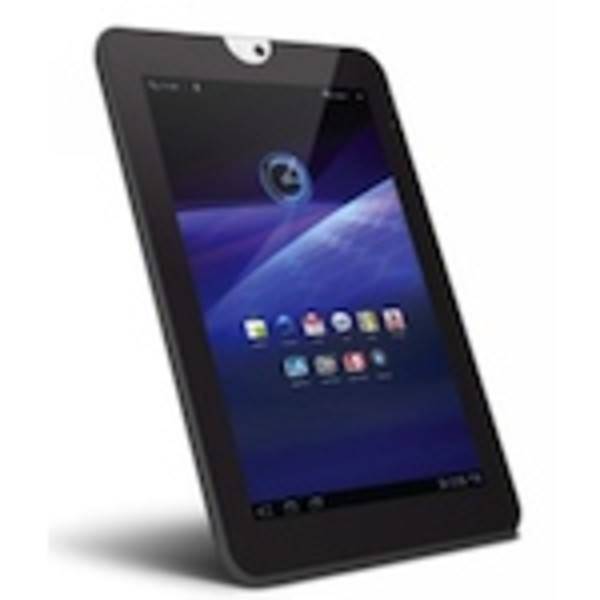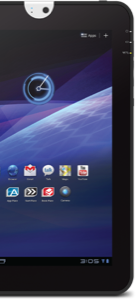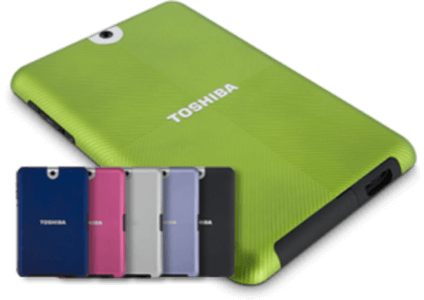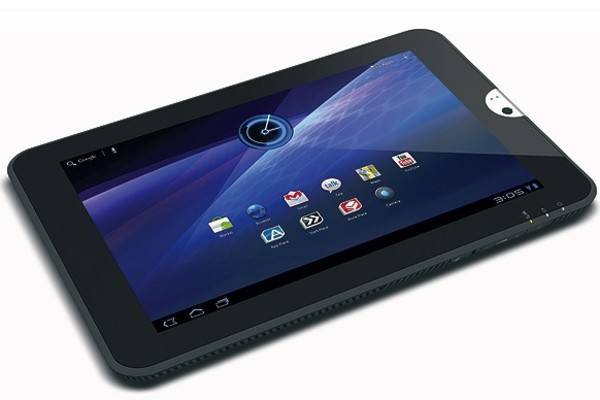I don’t hate the Toshiba Thrive Android tablet, which is probably the nicest thing I can say about it. Although heavy, it has a lot of ports. And it feels less heavy than it looks, I found. It runs a newer and more stable version of Android Honeycomb than some of its competitors do, too, so there are handful of geeky new features to enjoy. Overall, it’s not a bad Android tablet.

But at the end of the day, the question still remains: who will buy this tablet over the iPad?
I’ve been in search of a great Android tablet – one that would lure me away from the iPad. But I haven’t found it yet. I can’t even say the Thrive comes close, because frankly, anything heavier than the iPad 2 is non-starter for me.
Need More Ports? Thrive Has That. (Also, Lots of Extra Weight)
Android tablet makers have been criticized for focusing more on specs instead of on the overall ecosystem. And if any tablet is guilty of this, it’s surely the Toshiba Thrive. This tablet is more like a laptop, sans keyboard, especially if you go by the number of ports it offers. There’s a full-sized SD card slot, an HDMI port, a USB 2.0 slot, a mini USB port, a docking port, plus the usual headphone and power jacks.

Maybe all those ports are what make the tablet so beefy. It’s .62 inches thick, which is double that of the iPad 2 and Galaxy Tab 10.1. And at 1.66 pounds, it’s closer to the iPad and the Xoom (1.5-1.6 lbs) in weight than the iPad 2 (1.33 lbs). These small differences matter a lot when you’re talking about portable gadgets. After using the Thrive for reading, for example, it became uncomfortable to keep it propped up.
The Thrive also has a 10.1-inch 1280 x 800 pixel display, the same as the Motorola Xoom and Galaxy Tab 10.1, the same 1 GHz NVIDIA Tegra 2 processor as the Galaxy Tab and a better camera than the Tab (5 megapixels vs. the Tab’s 3 megapixels). Both have a 2 megapixels front camera, too. (If you really care about specs, you can delve into more of them here. We don’t review hardware in this way, however.)
But What Can You Do with the Thrive?

What’s more important is not the processor speed and pixel density, but what you can actually do with the tablet you purchase. Apple’s iPad has an answer for that question, with over 100,000 native iPad apps, and 425,000 apps in total that work on both iPhone and iPad, combined. And it has iTunes, the marketplace for movies, TV shows, music, podcasts and educational content. The iPad no longer struggles to answer the question, “what can you do on a tablet?” It’s now trying to limit the responses to the question of “what can you NOT do?”
That’s not to say Android isn’t making advances in this area. This spring, Google released an update to its Market which allowed users to rent movies and stream them to their devices. More recently, the mobile Android Market was updated so users could start the purchase process from their mobile, as opposed to only on the Web. But these are still baby steps, when you look at the larger challenge of reaching equity with the iPad.
For what it’s worth, the Thrive takes a big step forward in trying to answer the question of “what to do” with the inclusion of pre-installed software applications. Although sometimes unwelcome, in the case of the Thrive, the apps aren’t what we would call “bloatware.” That’s especially true since some of them that normally come with a hefty price tag are provided for free. The paid apps that ship with the Thrive include Quickoffice HD, LogMeIn Ignition and Kasperky’s Tablet Security. There are also a ton of free apps pre-installed, like Angry Birds, Backgammon, Toshiba’s own e-reader app “Book Place,” Google Books, several card games, NFS Shift (a racing game) andThe New York Times.
I also really liked the bundled PrinterShare app, which easily found my Wi-Fi printer and let me immediately print out photos, webpages, documents, messages, contacts, Gmail, and more, without any hassle. Too bad that you only get 5 free prints before having to upgrade to the paid version, though ($12.95 from Toshiba’s own store). That’s the kind of thing which Toshiba should have thrown in for free to make the tablet more competitive. It’s really a great feature.
Pure Honeycomb 3.1 if You Like That sort of Thing

On the software front, Toshiba’s Thrive is notable for the fact that it’s the first to ship with Android 3.1, the latest version of Honeycomb. That means you can do nifty things like resize your homescreen widgets and enjoy other minor user interface improvements, like a bigger “recent apps” list. And if you like Honeycomb, you’ll like the Toshiba Thrive because at the very least, Toshiba didn’t bog down the operating system (OS) with a overlay like Samsung’s TouchWiz or HTC’s Sense.
But…
Well, I’m just going to say it.
I don’t like Honeycomb. I don’t think it’s a great tablet OS in its current state. I don’t think that relocating the menus and controls that you find at the bottom of Android smartphones to the top of the screen on Android tablets makes sense. As you move back and forth between your Android phone and tablet devices, the swapped layout gets confusing.

Plus, everywhere you look, there’s some sort of button, control or menu system: search is accessed in the top-left, access to the apps menu is at the top-right, navigation buttons are in the bottom-left while notifications and the clock are in the bottom-right, similar to what you would find in Windows PC’s “system tray.” Because really, if you’re going to rip off a design, you would copy from Windows?
But it’s unfair to criticize Toshiba for Google’s design choices, and my own personal preferences. If you’re an Android geek at heart, you might enjoy Honeycomb quite a bit. If so, you’ll enjoy it more on a Toshiba Thrive.
At the end of the day, the Toshiba Thrive is a good enough Android tablet, maybe even one of the better ones, but it’s not a good enough answer to the question “why not an iPad?”
The Thrive is available in 8 GB ($429.99), 16 GB ($479.99) and 32 GB ($579.99) models.









